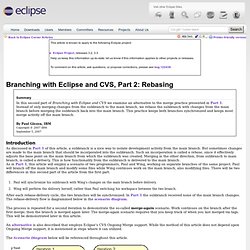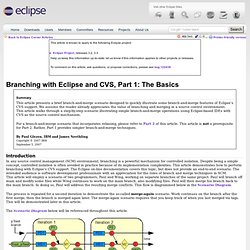

Corner Articles - Branching w/ Eclipse & CVS. Introduction As discussed in Part 1 of this article, a subbranch is a nice way to isolate development activity from the main branch.

But sometimes changes are made to the main branch that should be incorporated into the subbranch. Such an incorporation is called a rebase, since it effectively adjusts the base point on the main branch from which the subbranch was created. Merging in the other direction, from subbranch to main branch, is called a delivery. This is how functionality from the subbranch is delivered to the main branch. As in Part 1, this article will employ a scenario of two programmers, Paul and Wing, working on separate branches of the same project. Paul will synchronize his subbranch with Wing's changes on the main branch before delivery. After each rebase-delivery cycle, the two branches will be synchronized. The process is repeated for a second iteration to demonstrate the so-called merge-again scenario.
Setup The sample will use a few text files inside a simple project. Corner Articles - Branching w/ Eclipse & CVS. Introduction In any source control management (SCM) environment, branching is a powerful mechanism for controlled isolation.

Despite being a simple concept, controlled isolation is often avoided in practice because of its implementation complexities. This article demonstrates how to perform branching with Eclipse's CVS support. The Eclipse on-line documentation covers this topic, but does not provide an end-to-end scenario. The intended audience is software development professionals with an appreciation for the roles of branch and merge techniques in SCM. This article will employ a scenario of two programmers, Paul and Wing, working on separate branches of the same project. The process is repeated for a second iteration to demonstrate the so-called merge-again scenario. The Scenario Diagram below will be referenced throughout this article. Part 2 of this article adds the rebase operation to the scenario. Setup The sample will use a few text files inside a simple project.
Merge Method. Introduction to CVS. By Jennifer Vesperman 01/03/2002 This is the first in a two-part series on CVS. This article is intended for folks who will be using CVS already installed on a system. In it, the author explains check-out, update, adding, merging, and other functions. In the second part, scheduled to run later this month, she will show how to create and manage a CVS repository, for those who need to start from scratch. -- Ed. CVS -- or Concurrent Versioning System -- is a system for managing simultaneous development of files. CVS stores files in a central repository, set (using standard Unix permissions) to be accessible to all users of the files.
This system ensures that a history of the file is retained, which is extremely useful when the boss decides he wants a feature you trashed months ago. CVS is usually used to help manage projects, but can also be used for individual files. Typical Uses CVS is designed for developers, either individually or in teams. CVS is useful for writers. Updated successfully.